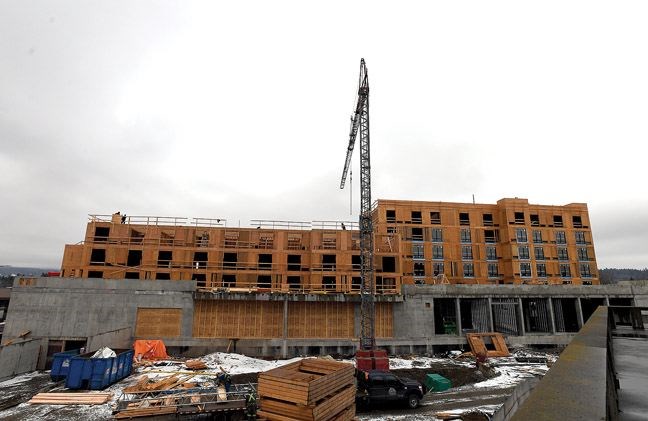Building permits have hit a record pace in Prince George, the population has expanded by more than 5,000 since 2011, the unemployment rate is falling and house prices are rising in a mid-size city ranked among the strongest economically in Canada.
But much of the good news ends at the outskirts of northern B.C.'s largest city.
In most of Canada, the economic divide between big urban centres and smaller towns is a gap. In nothern B.C., it's a chasm.
Unlike in Prince George, the jobless rate is rising and the population declining in the surrounding Cariboo, the northeast, Nechako and the north coast as a slump in forestry and delays in liquefied natural gas (LNG) projects derail the traction promised by the start of BC Hydro's Site C dam, the biggest construction project in the north.
"(The) Cariboo has lost jobs and people in recent years, trends that may stop but not reverse through 2018," warns Bryan Yu, senior economist with Central 1 Credit Union in Vancouver. "(The) north coast and Nechako will continue to suffer lost population and weak employment growth."
According to Central 1's recent economic analysis of B.C., the northeast could see some recovery in 2017, "but conditions will remain a challenge."
In Prince George, however, a fancy new $35 million Marriott hotel is under construction and city spokesman Michael Kellett confirms it is just part of the action in the city of 74,000.
"Prince George reached an all-time high in private-sector construction building permits in 2016," he said.
City records show that 96 per cent - $122.5 million - of building permits came from the private sector last year.
This included $72.6 million in residential permits.
Work on five new industrial ventures added another
$3.6 million. Add on permits for $5.2 million worth of institutional work and the total for 2016 was $127.9 million, making it the fourth-best year on record.
In addition, the city saw 446 new businesses established. In January, another $1.8 million in permits were taken, including for new homes, reflective of the city's 2.8 per cent population growth since 2011.
"It reinforces what has been happening in the city for a couple of years," said Prince George Mayor Lyn Hall.
"We've seen an increase in private-sector investment, and now, to see an increase in population, that will increase confidence from the private sector in investing in Prince George."
Hall added that the Conference Board of Canada has predicted Prince George will generate the strongest economic growth among seven mid-sized Canadian cities this year.
The city is also looking for more workers, according to Melissa Barcellos, the city's economic development manager.
"A lot of the employers have reported that one of the major constraints they're facing is filling their positions and they're having to recruit from outside Prince George because they can't fill them locally," Barcellos said.
The unemployment rate in Prince George is 7.1 per cent, up from 6.2 per cent a year ago, but still the lowest across the region.
In comparison, the northeast suffered a provincewide-worst 2.5 per cent employment decline in December and now has a 10.5 per cent unemployment rate.
Central 1 forecasts it will remain near that level through this year.
The northeast is the centre of British Columbia's natural gas fields and once seemed to be emerging as a major economic engine in the province. Three years ago, its unemployment rate was a provincewide-low 4.9 per cent and, along with Dawson Creek, it had the lowest rental vacancy rate and among the highest rents in B.C.
That has all reversed, but there are signs the northeast is finding another gear.
A strong signal flashed Jan. 18 when a one-day auction for oil and gas leases raised more money than every auction during the last two years.
Eight drilling licences brought in $39.6 million, including a record-setting $35 million parcel east of Dawson Creek.
The number of drill rigs working the northeast gas fields should increase about 31 per cent this year, said Mark Salkeld, president and CEO of the Petroleum Services Association of Canada. The association's forecast is for 367 wells in 2017, up from 280 in its original forecast in November.
"With luck and the favourable policies from governments, the (petroleum) services sector will pick itself up, dust itself off and get people and equipment back to work," Salkeld said.
The political help has already started and could spread the revival to the north coast.
In February, the B.C. government and two First Nations reached agreements they say will open the door to LNG development in Prince Rupert.
The deal, inked Feb. 15 in Victoria with Premier Christy Clark and officials from the Metlakatla and Lax Kw'alaams First Nations, is aimed at opening exports for B.C. natural gas from northeast B.C. via two pipelines.
Prince Rupert is the site of five of the more than 20 LNG projects proposed in B.C.
Pacific NorthWest LNG, led by Malaysia-based Petroliam Nasional Berhad (Petronas), is considered the most likely export terminal to move ahead. The project won federal government approval last September, with conditions.
February's B.C. budget made scant mention of LNG potential, but Natural Gas Minister Rich Coleman is still optimistic that Petronas will take a final investment decision this year.
For most northern outlier communities, such a decision would be a strong - and perhaps deciding - plank in bridging the widening economic gap with Prince George.



